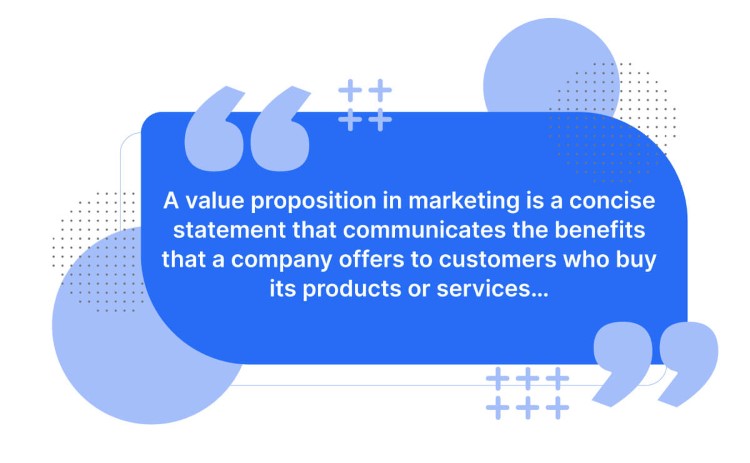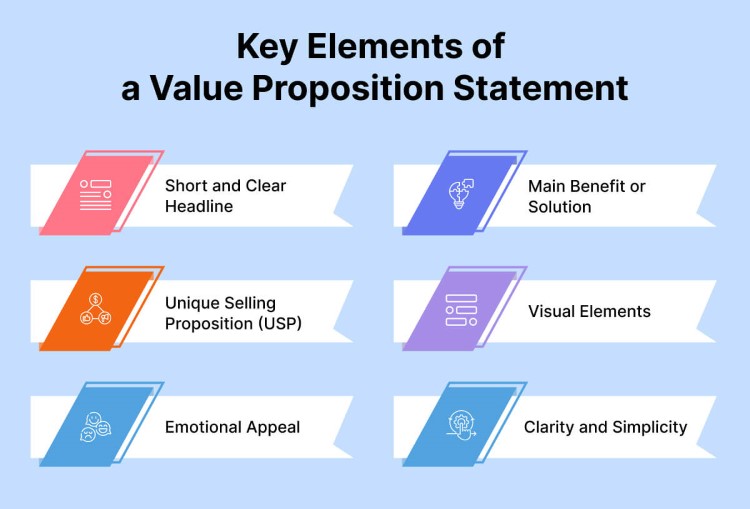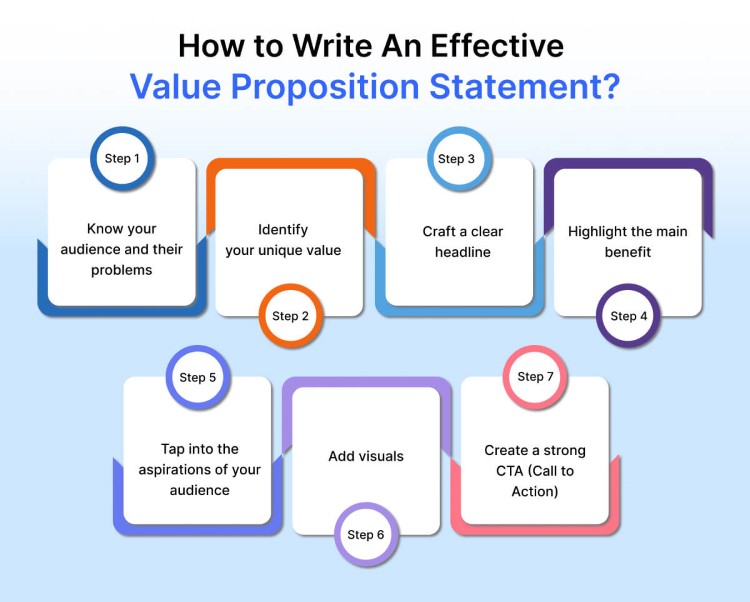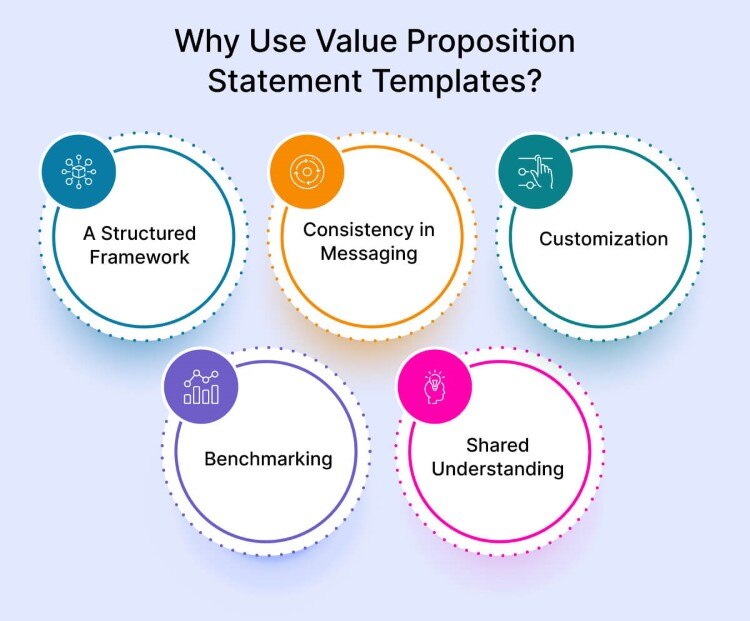Your business’s value proposition is a vital element of your overall marketing messaging. It’s also the core of your competitive advantage. A value proposition clearly articulates why prospects should choose you over competitors. Companies use it deftly to make the benefits of their products and services very clear to the target audience.
Despite all the obvious essences, many businesses either don’t highlight their value proposition or fail to figure it out at all. For some, it appears as a meaningless slogan or buzzword, so they obviously don’t bother to focus on it as much as they should.
But you can write a value proposition statement in a way that can drive conversion rates and sales. If you’re able to make it compelling, you can then draw huge benefits out of your marketing materials.
In this blog, we will first look at the definition of a value proposition statement, then explore its elements, see some examples, and understand how to craft effective ones for your business.
But first, let’s get started with understanding what a value proposition statement is…
What is a Value Proposition Statement?
A value proposition in marketing is a concise statement that communicates the benefits that a company offers to customers who buy its products or services. For businesses, it’s much more than a short statement as it promises value that you deliver to your customers.
More so, value propositions serve as key conversion factors and they could also be the difference between closing a sale or losing it. A good value proposition statement is one that accurately represents your offers to customers and posits you as the best choice for them.
- Value propositions are unique identifiers for the business.
- They convince customers to buy from you.
- Customers often prefer businesses whose value proposition is clearly marketed to them.
- A successful value proposition should be persuasive to turn prospects into paying customers.
Key Elements of a Value Proposition Statement
A value proposition is a concise yet compelling statement that gives customers a reason to choose your products or services over others. It’s a customer-centric marketing communication to tell the unique value of your product or service. Most importantly, the ultimate purpose of a value proposition statement is to make it clear why you’re the best choice for your customers.
Here are some of the key elements of a value proposition statement –
- Short and Clear Headline – It’s the first thing that your audience notices and it should be persuasive enough to pique their interest and grab their attention. A good headline not only captures the attention but also summarizes the main benefit in a succinct way.
- Main Benefit or Solution – This element clearly states what problem your product solves or what needs it fulfills. It has to be specific with a focus on the most important value for customers.
- Unique Selling Proposition (USP) – The USP of a value proposition highlights what makes your product or service unique or better, and what sets it apart from others in the market. It could be any distinct advantage you want to promote.
- Visual Elements – The more visually appealing your value proposition statement, the more easily it will catch the attention. It should include visuals such as images, graphics, or icons to add value to your message and make them stand out.
- Emotional Appeal – An effective value proposition is one that addresses the pain points of customers and appeals to their emotions. The key is to show how your product or service can make lives better for customers,
- Clarity and Simplicity – A simple and clear value proposition statement is always easy to understand as it is devoid of complex language and avoids confusing the audience.
How to Write An Effective Value Proposition Statement?
Writing an effective value proposition statement is vital for communicating the uniqueness of your offers to the target audience. However, the focus should always be on crafting a statement that makes heads turn and gets the message across. If you get the statement right, it can hugely boost the success rate of your marketing campaigns.
Here is a step-by-step guide to writing an effective value proposition statement –
Step 1 – Know your audience and their problems
When you’re about to create a value proposition statement, the first step is always to know your audience and their main problems. You must understand their needs, pain points, preferences, and desires. It’s equally important to collect customer feedback and gather insights into what customers want and what they value the most.
Step 2 – Identify your unique value
As a business, you should know what sets you apart from others in the market, or what makes your product or service different from competitors. This could easily be known once you focus on the main benefits that your product or service delivers to customers. The right way is to list the main benefit that you think meets a single customer need and then highlight it.
Step 3 – Craft a clear headline
A value proposition statement starts with a headline that is often clear and concise. It has to be short and capture the entire essence of your offers in a few words. Make sure the headline is specific and clear as then it will have more chances of grabbing the attention of your audience.
Step 4 – Highlight the main benefit
After crafting the headline, you need to move on to highlight the main benefit that your product or service offers. Make sure you keep this limited to one or two sentences and emphasize what problem your product solves or what needs it meets. Right after that, give a brief list of key features to support the claim of your main benefits.
Step 5 – Tap into the aspirations of your audience
Look, the value proposition statement you are crafting would be meaningless if it did not appeal to the aspirations of the audience. To achieve that goal, the easiest thing is to explain how your product or service can add value to their lives or how can your offers improve their lives. It’s equally important to be specific and credible and substantiate whatever claims you are making.
Step 6 – Add visuals
While your value proposition should be simple and easy to understand, it’s equally important to lace it with visuals and make it more engaging. Adding images, icons, or graphics could visually enhance your message and make it more appealing. But yes, make sure the visual elements you add are consistent with your brand’s identity.
Step 7 – Create a strong CTA (Call to Action)
Why would you create a value proposition statement if it does not encourage the audience to take some desired action? So, consider adding a strong CTA that is clear and persuasive. The key is to use action-driven language such as “Sign Up Now” or “Get Started” to see action.
Examples of Value Proposition Statement
Writing a memorable value proposition statement is very important as it has the potential to drive sales. You can use it to engage prospects and convert them into paying customers. Many companies understand the power of crafting a compelling value proposition and you could be one among them.
Here are some of the industry examples of how some brands have crafted their value proposition statement –
1. Airbnb Value Proposition Statement
Airbnb’s value proposition statement gets it simple and straight by effectively communicating why individuals should choose it over conventional hotels. Its value proposition is based on the unique benefits it offers to both guests and hosts.
Its headline, “Welcome Home” taps into the evolving preferences of new-day travelers who seek unique experiences and want to explore the best of sharing concepts and community building while renting out accommodation.
Its value proposition statement reads, “Airbnb offers travelers a unique way to experience the world by staying in local homes.”
2. Apple Value Proposition Statement
Apple’s value proposition resonates with consumers who seek not only products but a lifestyle marked with the ethos of innovation and creativity. The VPS aligns with Apple‘s vision of “thinking differently” and its products are considered pioneers in the segment.
Headline: “Think Different”
Its value proposition statement reads, “….to provide premium, high-quality technology products and services that simplify people’s lives, empower creativity, and enrich the living of its customers.”
The supporting features of the value proposition statement focus on design excellence, user-friendly interface, performance, privacy, and security.
3. Uber Value Proposition Statement
Uber’s value proposition statement is based on the core promise of “Effortless Transportation” and it resonates with consumers who seek convenient transportation in urban areas. The company has redefined mobility by leveraging technology and its value proposition blends together all elements that focus on convenience and efficient transportation for people in big cities.
Its value proposition statement focuses on how Uber offers on-demand transportation services and hassle-free rides in a car, bike, or scooter. The USP is obviously the way the Uber app connects rides with drivers and makes mobility effortless.
The main features highlighted by Uber include reliability, convenience, and safety of riders.
4. Nike Value Proposition Statement
Nike is a popular global brand whose value proposition is based on delivering top-quality athletic products and empowering athletes through style, comfort, and innovation. Its approach is holistic as blends product excellence with social responsibility and caters to those seeking fashionable and responsible athletic wear.
The core message of Nike‘s value proposition centers around supporting individuals in achieving their best performance and helping them unlock their full athletic potential. The company puts a strong focus on continuous innovation, and it also understands the value of comfort and style.
Why Use Value Proposition Statement Templates?
Many businesses use value proposition statement templates to craft, communicate, and refine their core message to the audience. These templates help create more effective messaging and also promote consistency and clarity.
Here are some of the reasons for using these templates –
- A Structured Framework – These templates give a structured framework for crafting value proposition statements. They have a proper flow and structure so that a business can incorporate key elements, USPs, and benefits and showcase the vision to the target audience.
- Consistency in Messaging – Templates are very helpful when it comes to maintaining consistency in messaging across channels. This helps you keep your value proposition consistent in all customer touchpoints and reinforce the message.
- Customization – Value proposition statement templates not only save time for teams in crafting value propositions but also enable customization to fit specific benefits and values. This promotes concise and focused communication.
- Benchmarking – You can use templates to benchmark your value proposition against competitors and easily identify the areas to excel or improve. You can also compare your statement with the industry and see whether it matches the standards.
- Shared Understanding – The use of templates can let you swiftly educate all the stakeholders about the elements of your value proposition. This kind of shared understanding often paves the way for more effective collaboration.
Popular Ways to Create a Good Value Proposition Statement For Your Business
You need to have a deep understanding of your target audience to write a compelling value proposition statement. It’s equally important to clearly articulate the unique benefits of your products and service as it will help you devise a transparent and customer-centric value proposition.
Here are some of the options and approaches you can leverage to create a good value proposition statement for your business –
1. Focus on Benefits-Oriented Approach
In this approach, your key focus should be on highlighting the primary benefits of your products or services to your customers. You must start the value proposition with a clear mention of the key benefits and also explain how these benefits will solve a specific problem for the audience.
An example of this approach
“Drive your customer engagement rate with our AI-powered software tool. Achieve amazing results without spending big on engaging your customers.”
2. Be Specific with Problem-Solution Approach
One of the key benefits of using this approach is that you can showcase your product or service as the solution to a specific problem or pain point of your customers. When this approach is used, the key is always to clearly state the problem your customers may be facing and your product can solve. Make sure you present your offers as the solution to the customer’s problem.
An example of this approach
“Not getting enough leads for your marketing efforts? Our chatbots can help automate some of your marketing tasks and help drive the leads.”
3. Adopt a Quantitative Approach for More Clarity
Numbers and stats can always drive home the point where flowery language can’t. So, you can think of using the power of data to highlight the quantifiable benefits that your product or service may offer to customers. To adopt this approach, make sure you subtly use the data with evidence that demonstrates the value to customers.
An example of this approach
“Boost your marketing ROI by 20% with our proven CRM tools. Many of our clients have already benefited with great results.”
4. Build Credibility
Building trust and credibility can help you craft a compelling and strong value proposition statement. In this approach, you will need to leverage the power of social proof such as testimonials and reviews to get the message across. Make sure you use powerful evidence of customer endorsement and use only reliable sources.
An example of this approach
“Join a long list of our happy customers who rely on our software for customer service. This product has all that you need to boost your marketing and sales.”
Conclusion
Value proposition can be the core of your competitive advantage besides being a key aspect of your overall marketing messaging. It’s important purely because it clearly lays down the reasons why people should choose you over others in the market.
So, your focus must be on using value proposition statements clearly and making the benefits of your offers obvious to the audience.
With REVE Chat, you can sign up for a variety of engagement tools and connect with your audience easily.








